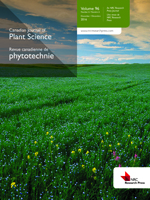Clark, M. J. and Zheng, Y. 2015. Species-specific fertilization can benefit container nursery crop production. Can. J. Plant Sci. 95: 251-262. To determine the responses of six container-grown shrub species to different controlled-release fertilizer (CRF) application rates, plant growth and root-zone traits were evaluated following fertilization with Polyon® 16-6-13, 5-6 month CRF incorporated at 0.60, 0.89, 1.19, 1.49 and 1.79 kg m-3 N. The six species tested at a southwestern Ontario, Canada, nursery were Cornus stolonifera ‘Flaviramea’ (yellow-twig dogwood), Euonymus alatus ‘Compactus’ (dwarf winged euonymus), Hydrangea paniculata ‘Grandiflora’ (Pee Gee hydrangea), Physocarpus opulifolius ‘Nugget’ (Nugget ninebark), Spiraea japonica ‘Magic Carpet’ (Magic Carpet spirea), Weigela florida ‘Alexandra’ (Wine and Roses weigela). Different species responded differently to the CRF rates applied. For the majority of species at the final harvest, growth index, plant height, canopy area, leaf area and above-ground dry weight were greater in high vs. low CRF rates; however, different species had different optimal CRF application rates or ranges: 1.49 kg m-3 N for Hydrangea and Spiraea, 1.19 kg m-3 N for Weigela, 1.19 to 1.49 kg m-3 N for Cornus and Physocarpus, and =0.60 kg m-3 N for Euonymus. Based on these species-specific optimal fertilizer rates or ranges, growers can group plant species with similar fertilizer demands, thereby reducing fertilizer waste and maximizing plant production.
How to translate text using browser tools
28 November 2014
Species-specific fertilization can benefit container nursery crop production
Mary Jane Clark,
Youbin Zheng
ACCESS THE FULL ARTICLE
It is not available for individual sale.
This article is only available to subscribers.
It is not available for individual sale.
It is not available for individual sale.

Canadian Journal of Plant Science
Vol. 95 • No. 2
March 2015
Vol. 95 • No. 2
March 2015
azote
leachate
lixiviat
Mineral nutrition
nitrogen
Nutrition minérale
optimal fertilizer rate




